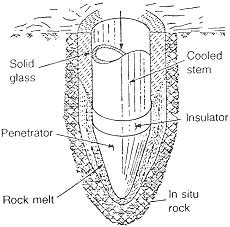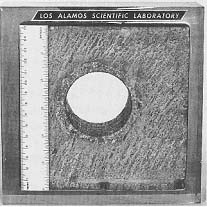

Consolidating Penetrator
The schematic diagram (Sims 1973, p. 7) shows how this novel drill bit penetrates loose soil or porous rock by melting it. Then the cooled drill stem consolidates the melted rock into a dense glass lining. The photograph (courtesy of John C. Rowley, Los Alamos National Laboratory) shows a hole melted through volcanic tuff by means of a consolidating penetrator. Note the dense (and therefore strong) hole liner.
Many aspects of mining may have to be altered profoundly for operations in an environment with low gravity, extreme temperatures, and high vacuum, at locations where direct human access and support will be exceedingly expensive. Because the differences between conventional and space operations may be drastic, it may be appropriate for us to evaluate radically different approaches.
One option that deserves attention is a rock melting system. This rock excavation method has been extensively investigated by Los Alamos National Laboratory (Neudecker, Giger, and Armstrong 1973; Sims 1973; Rowley 1974; Hanold 1977). Rock excavation by melting has been developed to an operational level for small- scale applications (drilling holes) and is proposed for large-scale applications (excavating tunnels).
For space applications, the system has the attractive feature of being self-contained; that is, of requiring minimal deliveries. It can, for example, melt its own liner in situ (in weak ground), thus obviating the need for additional support installation. However, it may require excessively high energy. It is interesting to note that the developers of rock melting for full- size tunneling envisioned the use of nuclear power, and it has been argued that nuclear power is essential for large-scale lunar development (Ehricke 1983).
The rock melting approach option is included here to stress the desirability of taking a broad view to identify appropriate technologies; that is, going well outside the bounds of conventional solutions. Whether rock melting is an appropriate alternative to conventional mining remains to be seen. A scoping meeting involving Los Alamos personnel associated with rock melting would seem a desirable first step to determining whether or not further evaluation is warranted.
![[NASA]](images/NASAball.gif)
![[Ames Research Center]](images/arclogo1.gif)
![[LifeSciences]](images/lslogot.gif)
![[Space Settlement]](images/splogosm.gif)